Model-Based Performance Optimization of Thermal Management System of Proton Exchange Membrane Fuel Cell
Abstract
:1. Introduction
2. Model Description and Methodology
2.1. System Description
2.2. Radiator Model Analysis and Building
2.3. 1D and 3D Coupled Simulation Model
3. Results and Discussion
3.1. Validation of Model
3.2. The Influence Analysis of Nanofluids
3.3. The Influence Analysis of Fin Parameters
4. Conclusions
- In order to verify whether nanofluids can improve the performance of the radiator, three kinds of nanofluids (Al2O3, SiO2 and ZnO) were selected for simulation tests and compared with pure water. The results show that the amount of heat transfer of the coolant can be improved by using nanofluids. When the mass flow rate is 0.02 kg/s and the concentration is 0.1 vol%, the amount of heat transfer of Al2O3, SiO2 and ZnO nanofluids increases by 9.5%, 9.1% and 4.2%, respectively, when compared with pure water. It is also found that the higher the concentration of nanoparticles, the greater the improvement in heat dissipation properties. However, the improvement in heat dissipation performance decreases as the coolant mass flow rate increases. The three nanofluids show the same trend.
- The increased heat dissipation capacity means that the frontal area of the radiator can be reduced. When the mass flow rate is 0.04 kg/s, by adding 0.5 vol% nanoparticles to pure water, the Al2O3 nanofluid can reduce the area by 12% when compared with pure water. Under the same conditions, the SiO2 and ZnO nanofluids can reduce the area by 11.67% and 9.17%, respectively. As the concentration of nanoparticles increases, the effect on frontal area reduction becomes larger. However, more pumping power is consumed and as the concentration of nanoparticles rises, the required pumping power rises. When the mass flow rate is 0.16 kg/s, by adding 0.5 vol% nanoparticles to pure water, the Al2O3 nanofluid can increase the pressure drop by 7.6% when compared with the base fluid. Under the same conditions, the SiO2 and ZnO nanofluids can increase the pressure drop by 6.1% and 5%, respectively. Although the Al2O3 nanofluid caused the most pressure drop, it has the best comprehensive performance and is suitable for use in the coolant to improve the heat dissipation capacity.
- A 1D-3D coupled model is established to study the temperature changes at the inlet and outlet of the stack using pure water and 0.5% Al2O3 nanofluid as a cooling medium. Through simulation analysis, it is found that the inlet and outlet temperature of the stack is about 10 °C lower when using nanofluid than when using pure water. The temperature difference of the coolant is smaller and the temperature variation is relatively mild, providing a good thermal environment for the operation of the stack.
- A porous media model is established and used to investigate the effects of fin pitch, wavy length, and wavy amplitude on the heat transfer performance of the radiator. In addition, 0.1% Al2O3 nanofluid is used as the cooling medium, and the mass flow rate is set at 0.08 kg/s. The results show that fin pitch, wavy amplitude and wavy length all have a significant effect on the heat dissipation capacity of the radiator, and the effect is more pronounced when the inlet air speed of the radiator is higher. The use of fin parameters with higher heat dissipation power results in lower coolant temperatures at the inlet and outlet of the stack, but the temperature difference does not change significantly. Among the nine groups of parameter values, group F has the best comprehensive heat dissipation performance and can be used for radiator parameter optimization.
Author Contributions
Funding
Data Availability Statement
Conflicts of Interest
References
- Park, J.; Oh, H.; Park, H.; Moon, J.W.; Lee, S.J.; Jung, S.Y. Water transport in polymer electrolyte membrane fuel cell: Degradation effect of gas diffusion layer. Int. J. Energy Res. 2022, 46, 9058–9070. [Google Scholar] [CrossRef]
- Wei, Y.; Zhao, Y.; Yun, H. Research on PEMFC Internal Temperature Predictions and Thermal Management Strategy Based on a Kalman Algorithm. J. Energy Eng. 2021, 147, 04021010. [Google Scholar] [CrossRef]
- Silva, A.P.; Galante, R.M.; Pelizza, P.R.; Bazzo, E. A combined capillary cooling system for fuel cells. Appl. Therm. Eng. 2012, 41, 104–110. [Google Scholar] [CrossRef]
- Song, T.-W.; Choi, K.-H.; Kim, J.-R.; Yi, J.S. Pumpless thermal management of water cooled high-temperature proton exchange membrane fuel cells. J. Power Sources 2011, 196, 4671–4679. [Google Scholar] [CrossRef]
- Zhang, Q.; Xu, L.; Li, J.; Ouyang, M. Performance prediction of proton exchange membrane fuel cell engine thermal management system using 1D and 3D integrating numerical simulation. Int. J. Hydrogen Energy 2018, 43, 1736–1748. [Google Scholar] [CrossRef]
- Islam, M.R.; Shabani, B.; Rosengarten, G. Nanofluids to improve the performance of PEM fuel cell cooling systems: A theoretical approach. Appl. Energy 2016, 178, 660–671. [Google Scholar] [CrossRef]
- Giuseppe, C.; Stefano, F.; d’Adamo, A. Methodology for PEMFC CFD Simulation Including the Effect of Porous Parts Compression. Int. J. Hydrogen Energy 2022, 47, 14658–14673. [Google Scholar]
- Dong, J.; Su, L.; Chen, Q.; Xu, W. Experimental study on thermal-hydraulic performance of a wavy fin-and-flat tube aluminum heat exchanger. Appl. Therm. Eng. 2013, 51, 32–39. [Google Scholar] [CrossRef]
- Chen, X.; Yu, Z.; Yang, C.; Chen, Y.; Jin, C.; Ding, Y.; Li, W.; Wan, Z. Performance investigation on a novel 3D wave flow channel design for PEMFC. Int. J. Hydrogen Energy 2021, 46, 11127–11139. [Google Scholar] [CrossRef]
- Rahimi-Esbo, M.; Ranjbar, A.; Ramiar, A.; Alizadeh, E.; Aghaee, M. Improving PEM fuel cell performance and effective water removal by using a novel gas flow field. Int. J. Hydrogen Energy 2016, 41, 3023–3037. [Google Scholar] [CrossRef]
- Alizadeh, E.; Rahimi-Esbo, M.; Rahgoshay, S.; Saadat, S.; Khorshidian, M. Numerical and experimental investigation of cascade type serpentine flow field of reactant gases for improving performance of PEM fuel cell. Int. J. Hydrogen Energy 2017, 42, 14708–14724. [Google Scholar] [CrossRef]
- Zhao, C.; Yang, J.; Zhang, T.; Yan, D.; Pu, J.; Chi, B.; Li, J. Numerical simulation of flow distribution for external manifold design in solid oxide fuel cell stack. Int. J. Hydrogen Energy 2017, 42, 7003–7013. [Google Scholar] [CrossRef]
- Bargal, M.H.S.; Souby, M.M.; Abdelkareem, M.A.A.; Sayed, M.; Tao, Q.; Chen, M.; Wang, Y. Experimental investigation of the thermal performance of a radiator using various nanofluids for automotive PEMFC applications. Int. J. Energy Res. 2021, 45, 6831–6849. [Google Scholar] [CrossRef]
- Johari, M.N.I.; Zakaria, I.A.; Azmi, W.H.; Mohamed, W.A.N.W. Green bio glycol Al2O3-SiO2 hybrid nanofluids for PEMFC: The thermal-electrical-hydraulic perspectives. Int. Commun. Heat Mass Transf. 2022, 131, 105870. [Google Scholar] [CrossRef]
- Islam, R.; Shabani, B.; Andrews, J.; Rosengarten, G. Experimental investigation of using ZnO nanofluids as coolants in PEM fuel cell. Int. J. Hydrogen Energy 2017, 42, 19272–19286. [Google Scholar] [CrossRef]
- Peng, M.; Chen, L.; Zhang, R.; Xu, W.; Tao, W.-Q. Improvement of thermal and water management of air-cooled polymer electrolyte membrane fuel cells by adding porous media into the cathode gas channel. Electrochim. Acta 2022, 412, 140154. [Google Scholar] [CrossRef]
- Mao, S.; Cheng, C.; Li, X.; Michaelides, E.E. Thermal/structural analysis of radiators for heavy-duty trucks. Appl. Therm. Eng. 2010, 30, 1438–1446. [Google Scholar] [CrossRef]
- Huang, Y.-Q.; Huang, R.; Yu, X.-L.; Lv, F. Simulation, experimentation, and collaborative analysis of adjacent heat exchange modules in a vehicular cooling system. J. Zhejiang Univ. Sci. A 2013, 14, 417–426. [Google Scholar] [CrossRef]
- Huang, Y.; Liu, Z.; Lu, G.; Yu, X. Multi-scale thermal analysis approach for the typical heat exchanger in automotive cooling systems. Int. Commun. Heat Mass Transf. 2014, 59, 75–87. [Google Scholar] [CrossRef]
- Zhang, Q.; Qin, S.; Ma, R. Simulation and experimental investigation of the wavy fin-and-tube intercooler. Case Stud. Therm. Eng. 2016, 8, 32–40. [Google Scholar] [CrossRef]
- Al-Asadi, M.T.; Alkasmoul, F.S.; Wilson, M.C.T. Heat transfer enhancement in a micro-channel cooling system using cylindrical vortex generators. Int. Commun. Heat Mass Transf. 2016, 74, 40–47. [Google Scholar] [CrossRef]
- Hussein, A.M.; Bakar, R.A.; Kadirgama, K. Heat transfer enhancement using nanofluids in an automotive cooling system. Int. Commun. Heat Mass Transf. 2014, 53, 195–202. [Google Scholar] [CrossRef]
- Mus, J.; Mylle, S.; Schotte, S.; Fevery, S.; Latré, S.K.; Buysschaert, F. CFD Modelling and Simulation of PEMFCs in STAR-CCM+. In Proceedings of the 2022 11th International Conference on Renewable Energy Research and Application (ICRERA), Istanbul, Turkey, 18–21 September 2022. [Google Scholar]
- McDonald, A.G.; Magande, H.L. Fundamentals of heat exchanger design. In Introduction to Thermo-Fluids Systems Design; John Wiley & Sons Ltd. Hoboken: Hoboken, NJ, USA, 2012; pp. 127–211. [Google Scholar]
- Dong, J.; Zhang, Y.; Li, G.; Xu, W. Experimental Study of Wavy Fin Aluminum Plate Fin Heat Exchanger. Exp. Heat Transf. 2013, 26, 384–396. [Google Scholar]
- Cui, Y. Numerical Simulation of Enhanced Heat Transfer of Nanofluid in the Cooling Chamber of Internal Combustion Engine; Dalian Jiaotong University: Dalian China, 2016. [Google Scholar]
- Li, Q.; Xuan, Y. Convective heat transfer and flow characteristics of Cu-water nanofluid. Sci. China 2002, 45, 408–416. [Google Scholar]
- Sajadi, A.R.; Kazemi, M.H. Investigation of turbulent convective heat transfer and pressure drop of TiO2/water nanofluid in circular tube. Int. Commun. Heat Mass Transfer. 2011, 38, 1474–1478. [Google Scholar] [CrossRef]
- Huang, D.; Wu, Z.; Sunden, B. Pressure drop and convective heat transfer of Al2O3/water and MWCNT/water nanofluids in a chevron plate heat ex changer. Int. J. Heat Mass Transfer. 2015, 89, 620–626. [Google Scholar] [CrossRef]
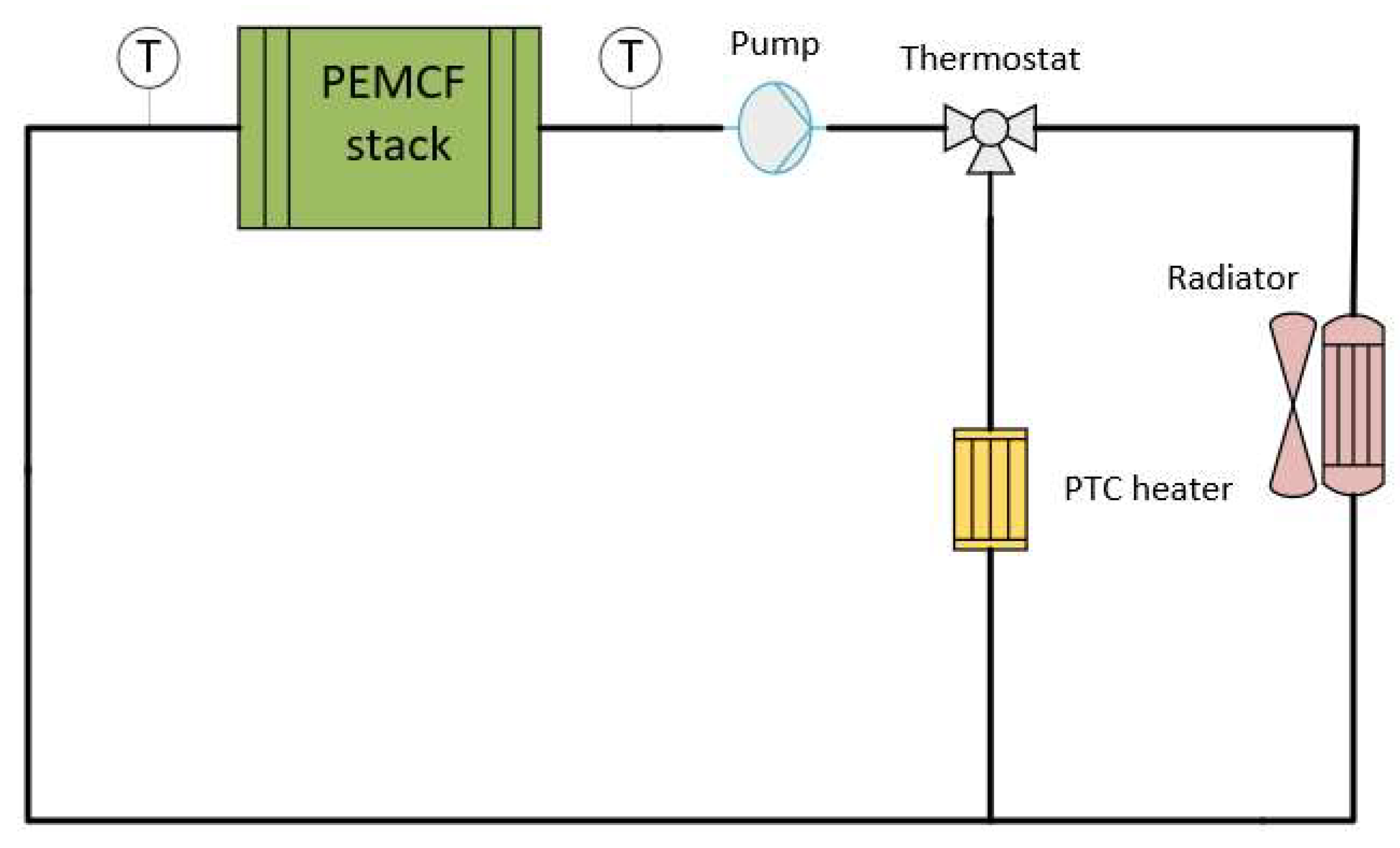
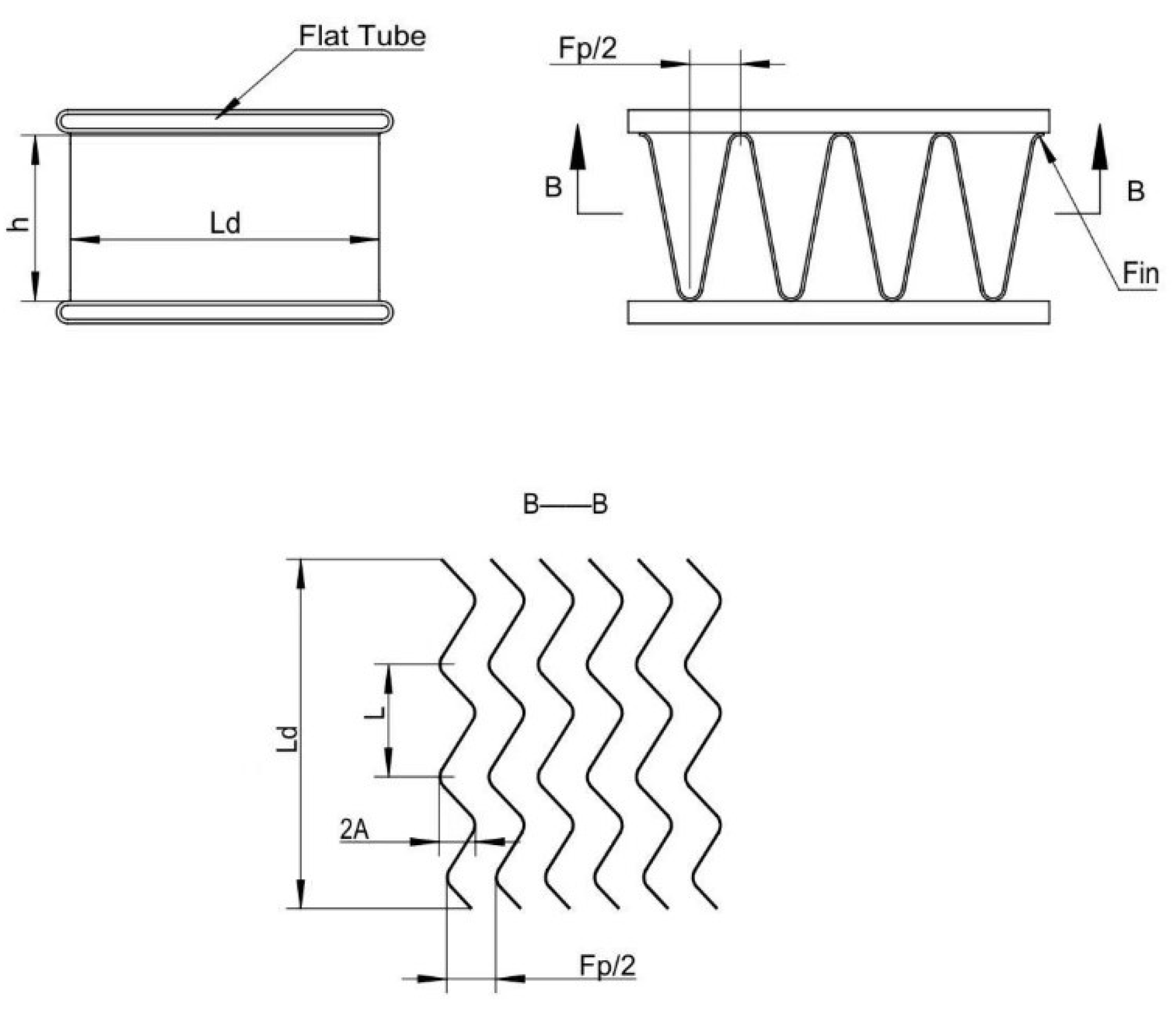


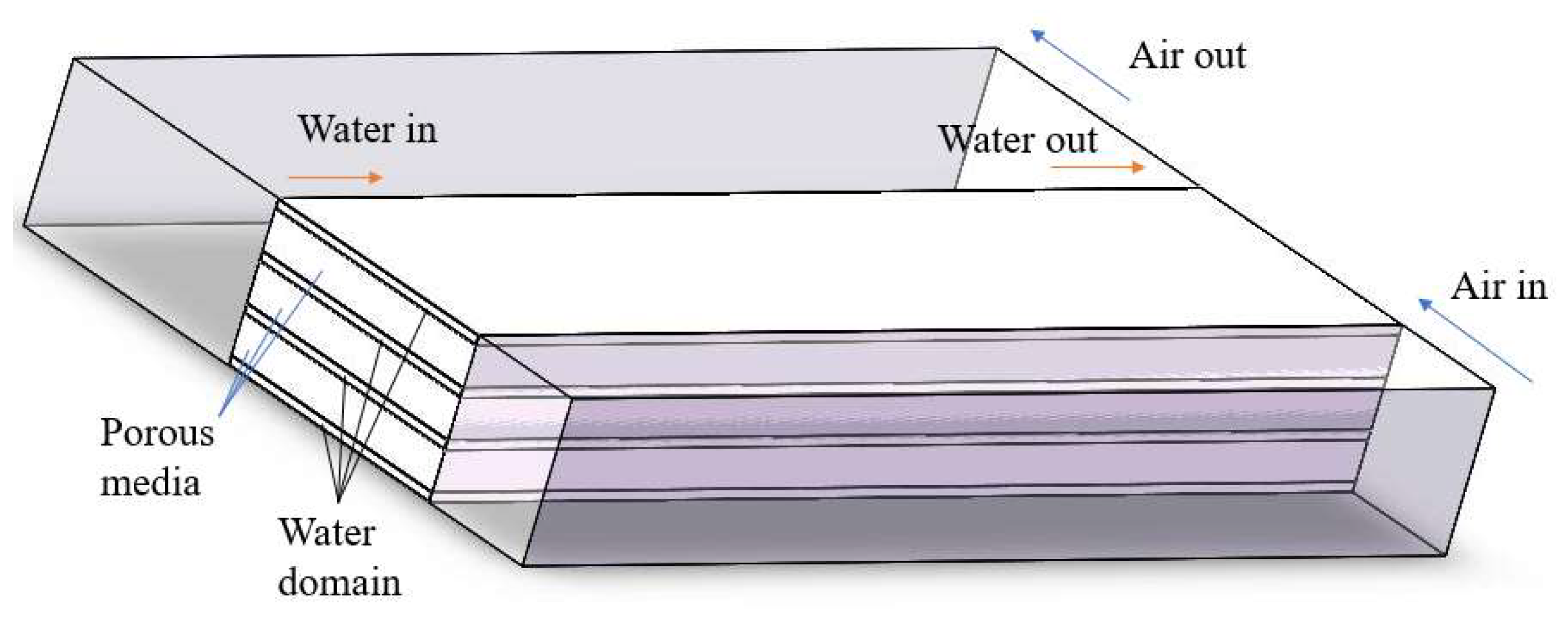
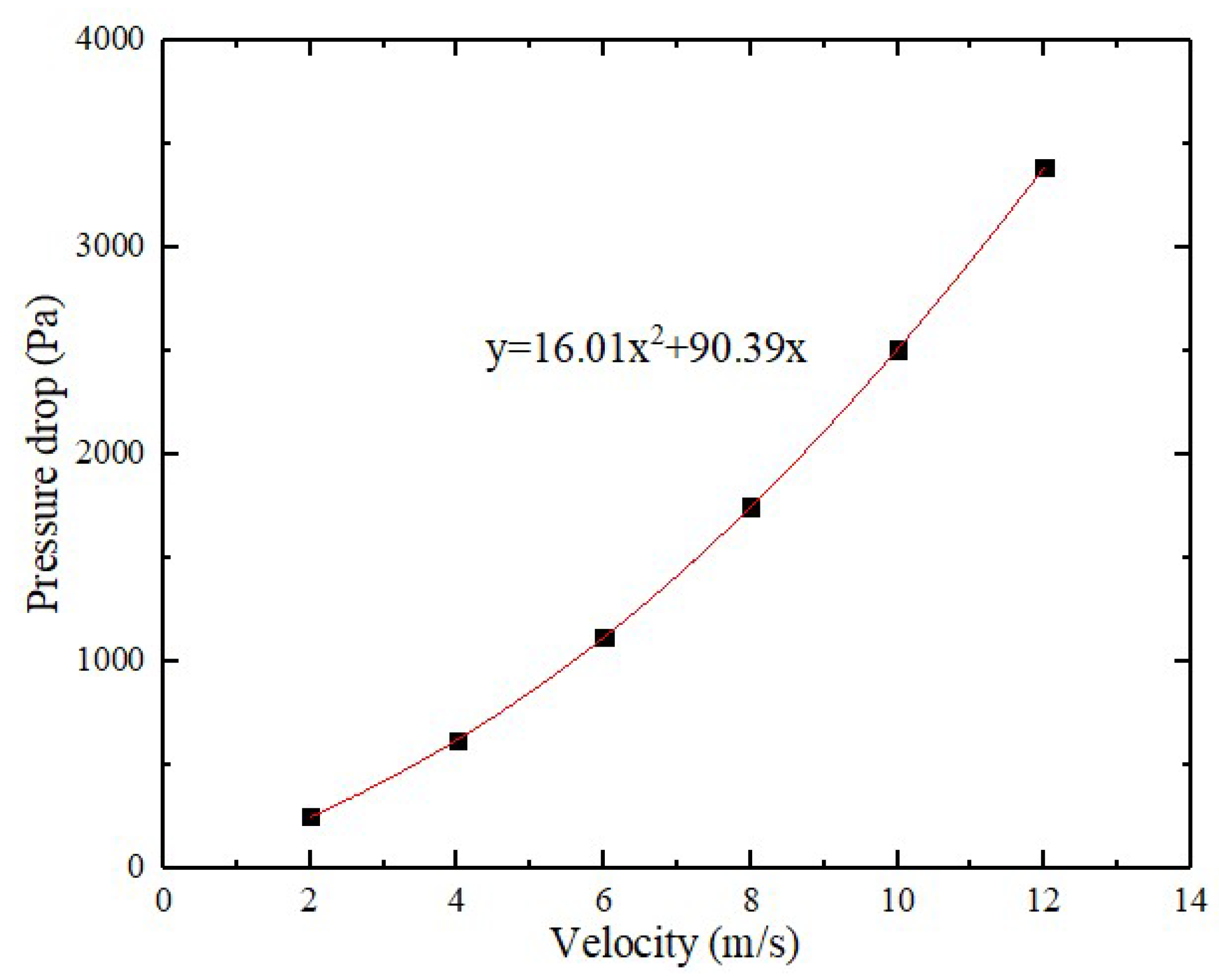

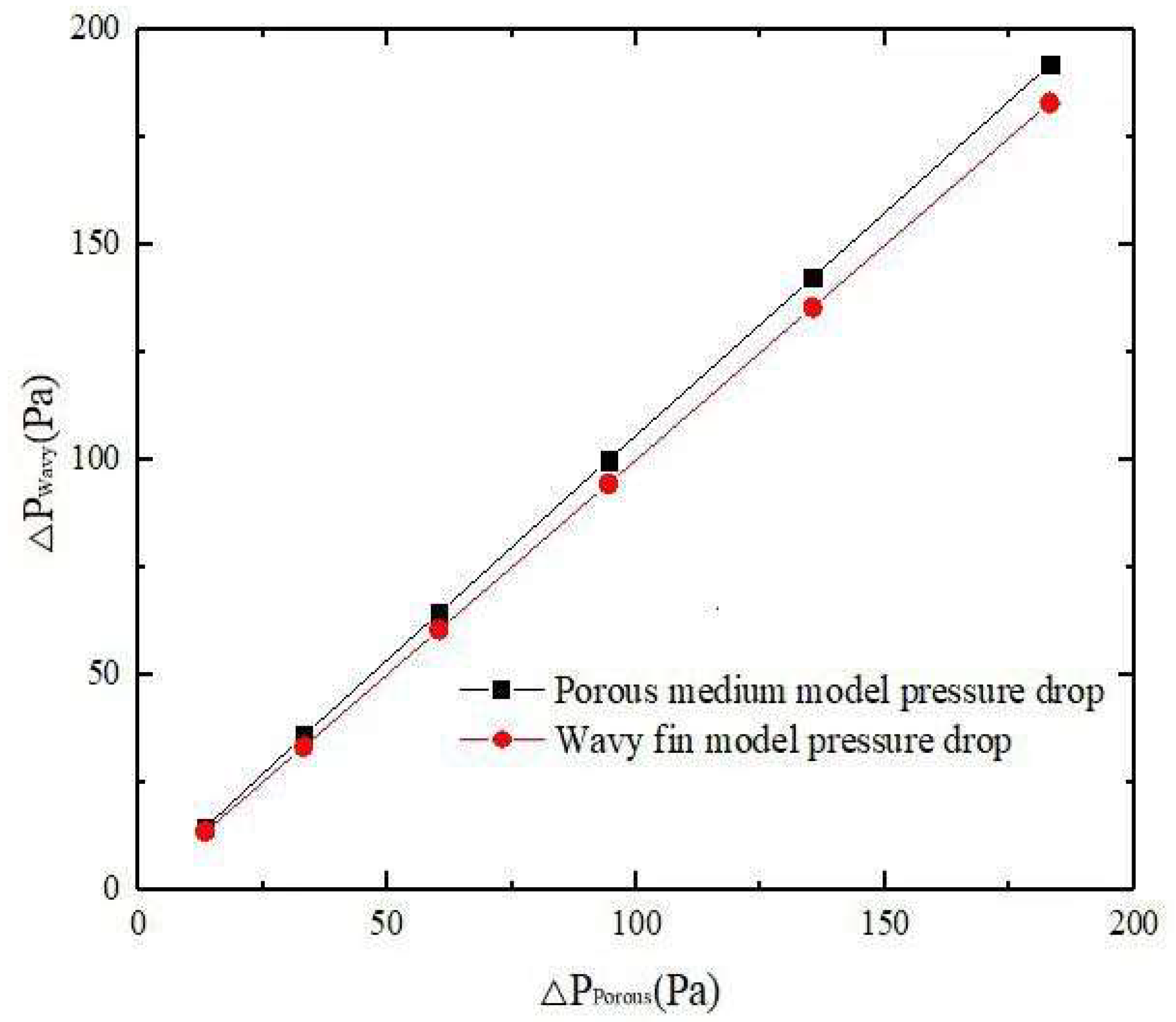




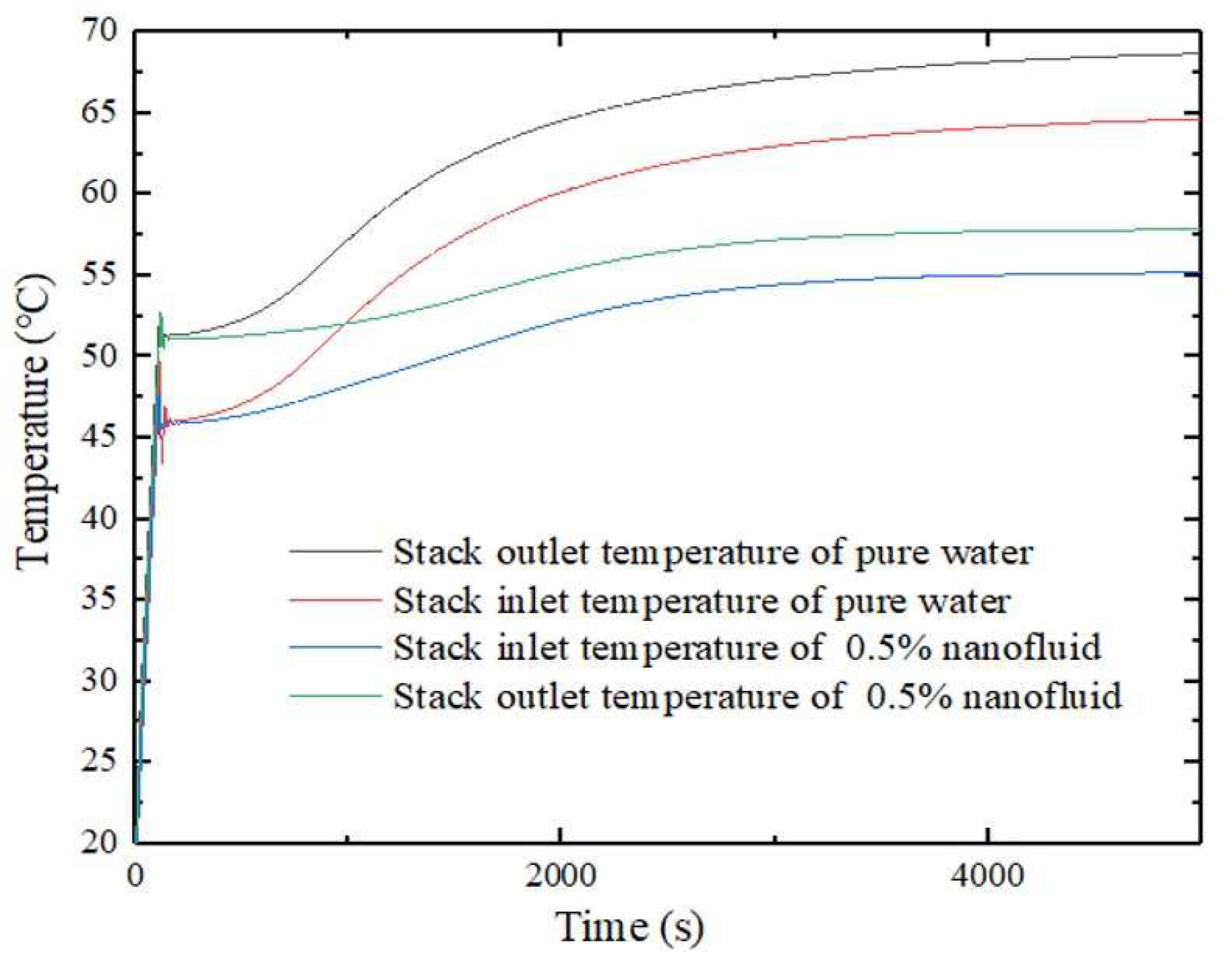
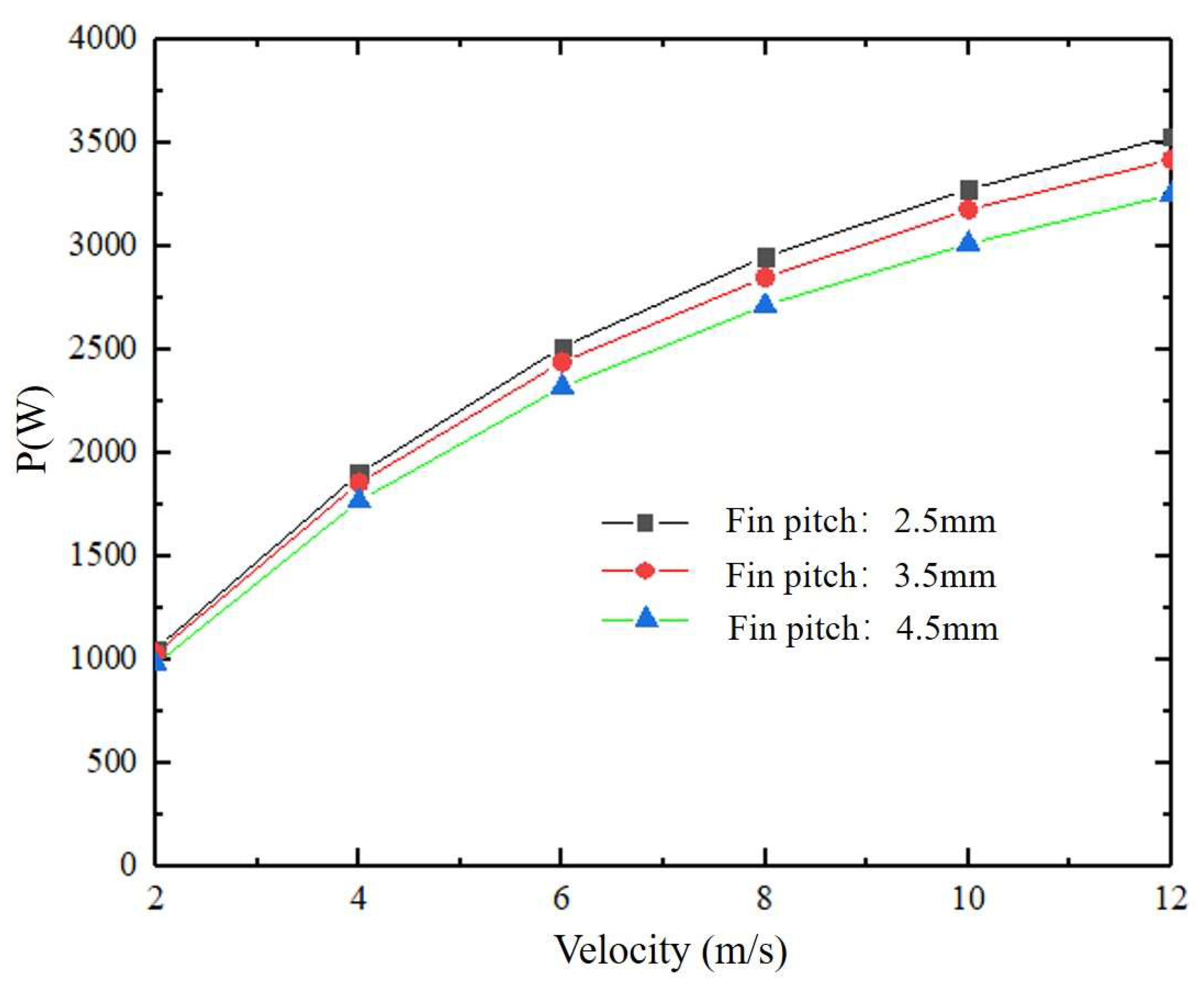
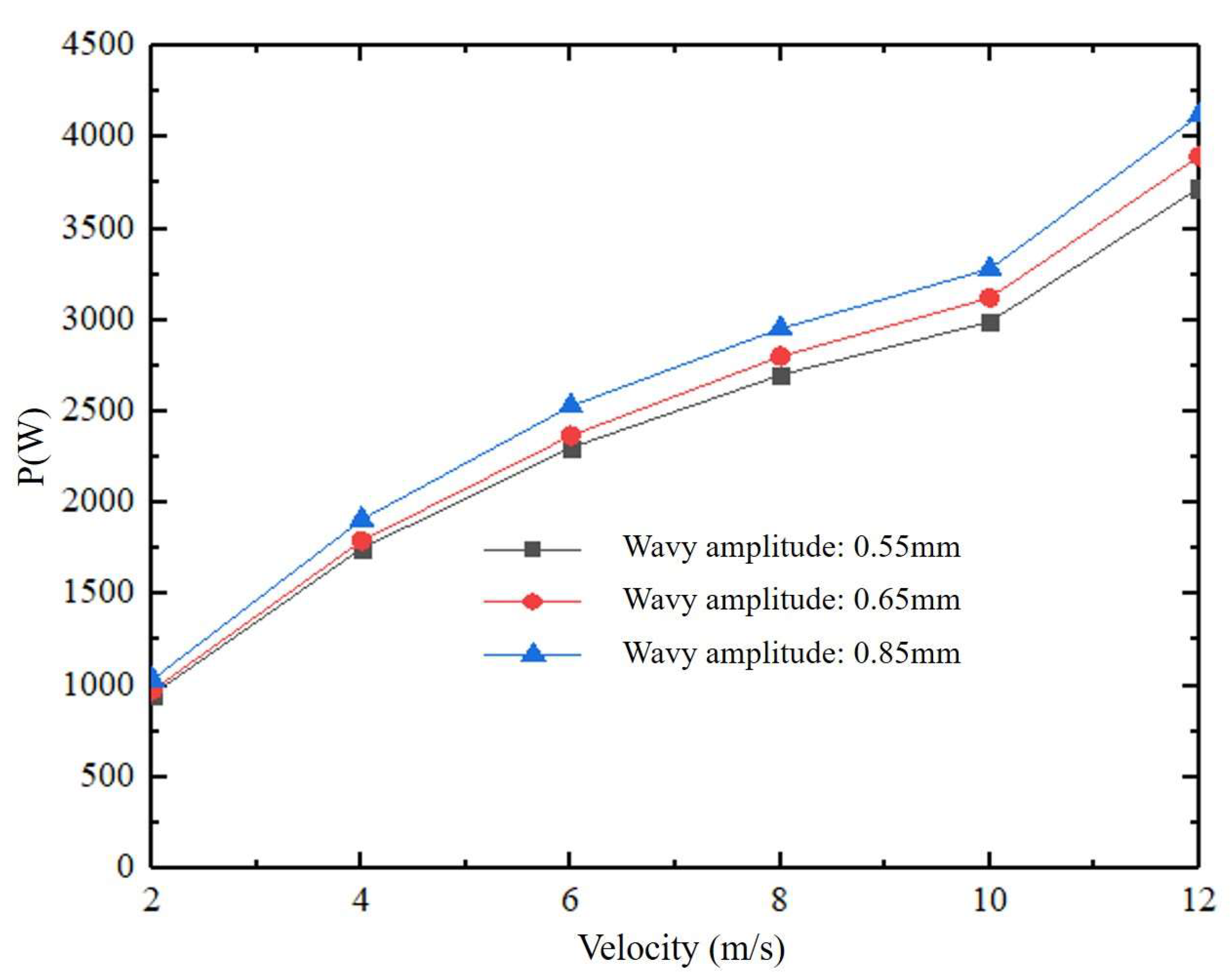

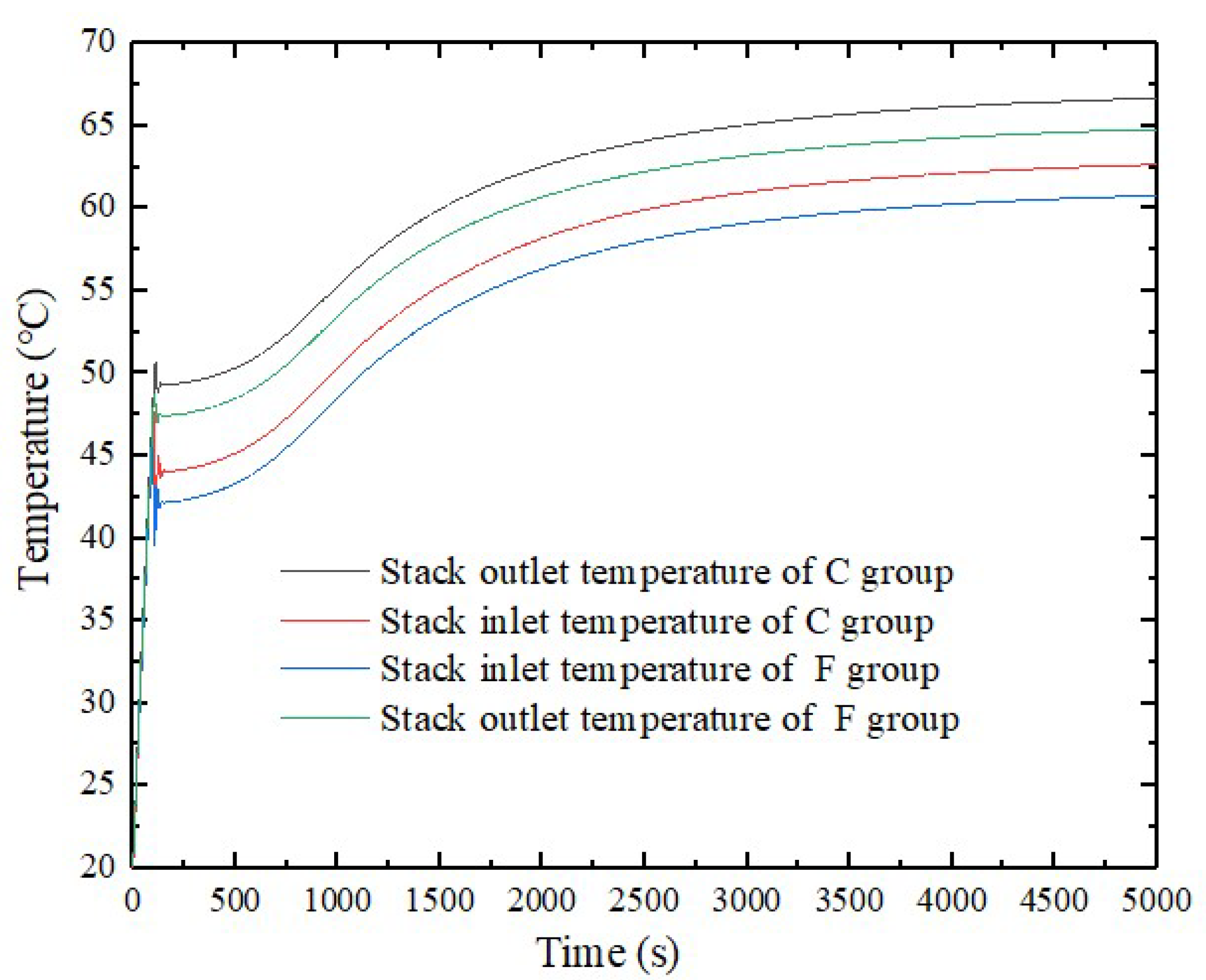
| Fin Pitch (Fp)/mm | Fin Height (h)/(mm) | Fin Length (Ld)/(mm) | Wavy Length (L)/(mm) | Wavy Amplitude (2A)/(mm) | Fin Thickness (δ)/(mm) | Flat Tube Height /(mm) |
|---|---|---|---|---|---|---|
| 4 | 7.5 | 54 | 10.8 | 0.75 | 0.2 | 1.5 |
| Material | Density (kg∙m−3) | Specific Heat (J∙kg−1∙K−1) | Thermal Conductivity (W∙m−1∙K−1) |
|---|---|---|---|
| Pure water | 997.561 | 4081.72 | 0.620271 |
| Air | 1.293 | 1003.62 | 0.02603 |
| Aluminum | 2702 | 903 | 237 |
| Concentration | Density/ (kg∙m−3) | Specific Heat/ (J∙kg−1∙K−1) | Thermal Conductivity/ (W∙m−1∙K−1) | Viscosity/ (Pa∙s) |
|---|---|---|---|---|
| 0.1% | 974.42 | 4191.45 | 0.97 | 3.60 × 10−4 |
| 0.3% | 979.68 | 4184.36 | 1.06 | 3.87 × 10−4 |
| 0.5% | 984.94 | 4177.27 | 1.27 | 3.89 × 10−4 |
| Concentration | Density/ (kg∙m−3) | Specific Heat/ (J∙kg−1∙K−1) | Thermal Conductivity/ (W∙m−1∙K−1) | Viscosity/ (Pa∙s) |
|---|---|---|---|---|
| 0.1% | 973.14 | 4191.77 | 1.04 | 3.39 × 10−4 |
| 0.3% | 975.84 | 4185.31 | 1.17 | 3.45 × 10−4 |
| 0.5% | 978.54 | 4178.86 | 1.41 | 3.50 × 10−4 |
| Concentration | Density/ (kg∙m−3) | Specific Heat/ (J∙kg−1∙K−1) | Thermal Conductivity/ (W∙m−1∙K−1) | Viscosity/ (Pa∙s) |
|---|---|---|---|---|
| 0.1% | 1049.85 | 3409.73 | 0.425 | 1.51 × 10−4 |
| 0.3% | 1054.13 | 3397.45 | 0.434 | 1.62 × 10−4 |
| 0.5% | 1062.29 | 3374.92 | 0.446 | 1.97 × 10−4 |
| Item | Fin Height (h)/(mm) | Fin Thickness (δ)/(mm) | Flat Tube Height /(mm) | Fin Length (Ld)/(mm) | Fin Pitch (Fp)/(mm) | Wavy Amplitude (2A)/(mm) | Wavy Length (L)/(mm) |
|---|---|---|---|---|---|---|---|
| A | 7.5 | 0.2 | 1.5 | 54 | 2.5 | 0.75 | 10.8 |
| B | 7.5 | 0.2 | 1.5 | 54 | 3.5 | 0.75 | 10.8 |
| C | 7.5 | 0.2 | 1.5 | 54 | 4.5 | 0.75 | 10.8 |
| D | 7.5 | 0.2 | 1.5 | 54 | 4 | 0.55 | 10.8 |
| E | 7.5 | 0.2 | 1.5 | 54 | 4 | 0.65 | 10.8 |
| F | 7.5 | 0.2 | 1.5 | 54 | 4 | 0.85 | 10.8 |
| G | 7.5 | 0.2 | 1.5 | 54 | 4 | 0.75 | 6.8 |
| H | 7.5 | 0.2 | 1.5 | 54 | 4 | 0.75 | 8.8 |
| I | 7.5 | 0.2 | 1.5 | 54 | 4 | 0.75 | 12.8 |
Disclaimer/Publisher’s Note: The statements, opinions and data contained in all publications are solely those of the individual author(s) and contributor(s) and not of MDPI and/or the editor(s). MDPI and/or the editor(s) disclaim responsibility for any injury to people or property resulting from any ideas, methods, instructions or products referred to in the content. |
© 2023 by the authors. Licensee MDPI, Basel, Switzerland. This article is an open access article distributed under the terms and conditions of the Creative Commons Attribution (CC BY) license (https://creativecommons.org/licenses/by/4.0/).
Share and Cite
Zhang, J.; Yan, F.; Du, C.; Li, W.; Fang, H.; Shen, J. Model-Based Performance Optimization of Thermal Management System of Proton Exchange Membrane Fuel Cell. Energies 2023, 16, 3952. https://doi.org/10.3390/en16093952
Zhang J, Yan F, Du C, Li W, Fang H, Shen J. Model-Based Performance Optimization of Thermal Management System of Proton Exchange Membrane Fuel Cell. Energies. 2023; 16(9):3952. https://doi.org/10.3390/en16093952
Chicago/Turabian StyleZhang, Jiaming, Fuwu Yan, Changqing Du, Wenhao Li, Hongzhang Fang, and Jun Shen. 2023. "Model-Based Performance Optimization of Thermal Management System of Proton Exchange Membrane Fuel Cell" Energies 16, no. 9: 3952. https://doi.org/10.3390/en16093952





